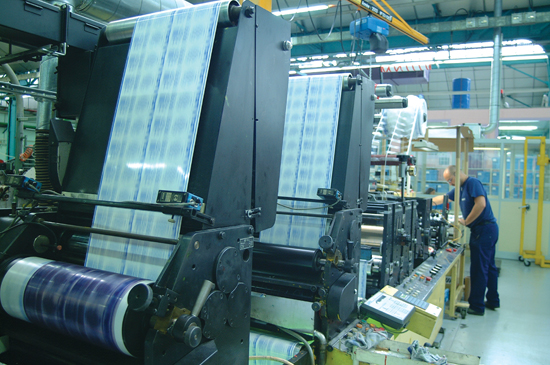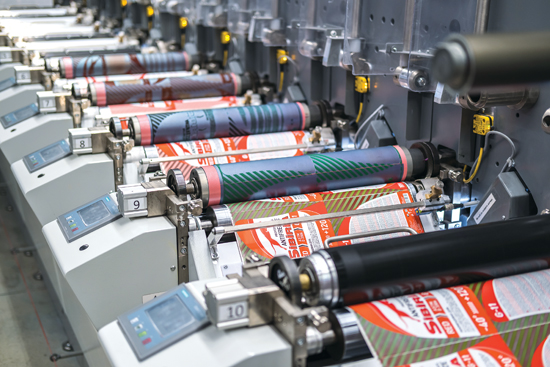
Features
Digital Finishing
Digital Printing
Packaging
Printing
Opportunities for printers
Future-proof the business by adopting new technologies
August 6, 2021 By David Pittman
 Label printers are embracing different technologies to successfully respond to consumer needs. Photo © Simon Coste / Adobe Stock
Label printers are embracing different technologies to successfully respond to consumer needs. Photo © Simon Coste / Adobe Stock It has been a few decades since the term “digital” first entered the lexicon of the label printing industry. Since then, those at the bleeding edge and adopting when the market was still very much embryonic have been supplanted by a mature customer base deploying tried, tested and refined solutions as digital printing has become commonplace.
With the technology evolving—faster speeds, better quality, increased consistency etc.—the market has embraced the opportunities digital printing permits. This has been realized in pressrooms the world over through hardware installations, as printers look to respond to 21st century consumer behaviours, the advent of short runs, personalization and brand owner demands for new business models to provide just-in-time delivery and minimize waste in the supply chain. Due to these factors, many digital adopters in labels are operating multiple lines. They are also embracing the different digital printing technologies and the unique characteristics and capabilities of each to further their ability to respond to today’s business environment, and that of tomorrow.
Choosing the right technology
Increasingly, the end-use is driving the choice of technology, be that:
- challenging substrates as often seen in wines and spirits;
- durable labels that are resistant to various types of environmental factors;
- beer and beauty labels, where achieving the correct look and feel is paramount; or food labels, which must be esthetically pleasing whilst meeting stringent regulations for food safety.
For most, digital presses are slotted in alongside flexo and offset machines. There are examples—from the early days—of this approach not providing the most effective route to ROI, with the capabilities and capacities of digital printing undermined by attempts to make the technology work within existing workflows. Today, it is widely acknowledged that to make the most of an investment in digital, the ecosystem around the press is as important as the machine itself. This helps get incoming orders through prepress, onto the print engine, then forward to finishing and converting in the most streamlined and effective way possible.

A web-to-print business model will help increase orders for label printers. Photo © hiv360 / Adobe Stock
Workflow automation
The starting point is invariably the correct MIS/ERP, designed to handle the greater number of orders and jobs, the complexities of such work and the amount of data involved, whilst being able to keep up with the press and keep it filed with saleable work. Web-to-print business models are now springing up at an increasing rate, bringing the convenience of e-commerce as experienced by consumers on a daily basis to the business-to-business world. While this will not work for all, it’s likely that a growing amount of work destined for digital label presses will come from online avenues. This then creates an entirely different structure for label printers who might be more au fait with established workflows that see orders coming through the door and being processed by the prepress department.
The likely deskilling of the prepress process will result in a need for companies to find new roles for staff. This can be a boon for many, as it creates new opportunities for growth, taps up under-utilized resources within a workforce and strengthens the personal development roadmap for staff. This may seem scary to some, but it is an inevitable consequence of digital transformation. It should not be feared, but embraced and made a part of corporate strategies for the future.
Resurgence of flexo
Similarly, there were concerns about the impact of digital transformation on analogue print processes. Driven, in part, by the digital industry’s excellent marketing activities and loud vocal presence permeating the supply chain, the furore reached a fever pitch. There was a brief point in time when the digital printing industry was having to go on record to state, “We’re not here to kill flexo.” In recent years, the flexo industry has staged a ‘fightback’ and gone through a technical resurgence of its own, including efficiency gains, automation of press set-up and better standardisation of the process. It has also got more vocal and better at fighting its corner. Its marketing efforts have improved to highlight the strengths of flexo in the 21st century.
Complimentary processes
As a result, the reality on the factory floor today is that digital and analogue are entirely complementary print processes. This is realised through the growing amount of ‘hybrid’ options—full hybrid, true hybrid, integrated hybrid, etc.—that combine the best of both processes, as well as the capacities that have been freed up and created. By taking the burden off a flexo press to print short runs when implementing a digital printing workflow, for example, label printers can increase the amount of volume work they put through their Gallus/Mark Andy/Nilpeter/MPS/Bobst press. Similarly, digital presses are now able to take on longer runs, leaving a flexo press free to produce the highest value jobs, perhaps. This maximizes OEE and hastens the ROI for both digital and analogue hardware. For many label printers, this has now opened up new business opportunities and markets they may have previously been unable to service.
Flexible packaging
One such opportunity has been digitally printed flexible packaging. Flexible packaging is a widely spoken about goal for label printers. Technical challenges remain in this area, given the greater demands placed on primary packaging, and how it relates to established label printing technologies such as UV. However, work is ongoing in the supply chain to mitigate and alleviate such concerns. Further, a growing amount of hardware is now available to permit fast turnaround of digitally printed flexible packaging constructions, printed using either aqueous inkjet or toner technologies and suited to ‘print-for-use’ business models. There remains a need for education amongst label printers, as flexible packaging materials and end uses are entirely different. That being said, it’s likely we’ll see more and more label converters moving into flexible packaging as opportunities present themselves.
Digital finishing
Adding value is another area of opportunity for label printers deploying digital. In the ongoing battle to win at the ‘moment of truth,’ and offer the greatest shelf appeal, more and more systems are being introduced to enhance and embellish digitally printed labels with either post-print analogue processes, or newer digital-native systems that can apply foils, varnishes and other visual effects, as well as haptic elements to appeal to consumers’ desire to touch and feel.
As such, I believe the label industry is well placed to embrace the next iteration of digital transformation by coupling its engrained knowledge of digital printing with a capacity to adapt and change. Rather than being fretful, the label industry is looking forward to how digital can future-proof business, and is ready to embrace all the opportunities this will present.
David Pittman is the editor of Digital Labels & Packaging. This article was originally published as part of the Drupa Essentials of Print series. It also appeared in the July/August 2021 issue of PrintAction.
Print this page
